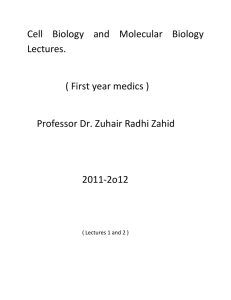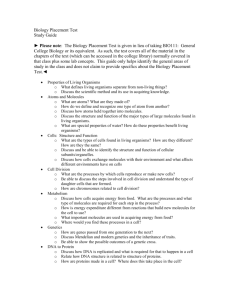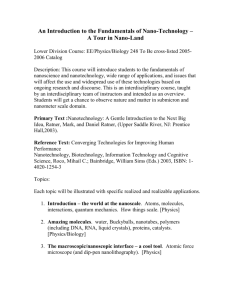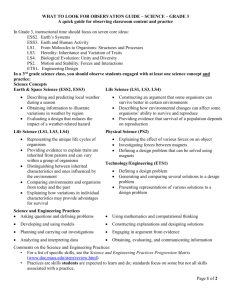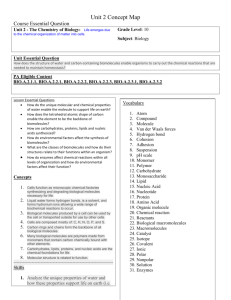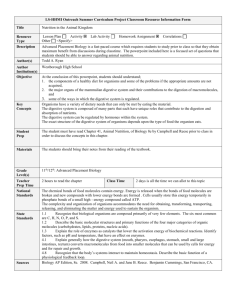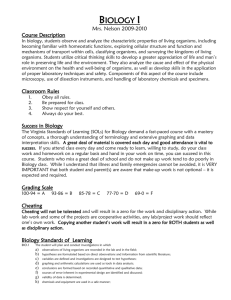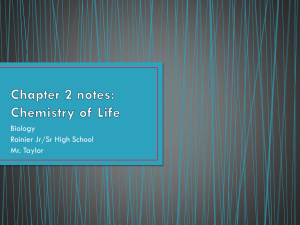BIOLOGY - wcpssccsi
advertisement
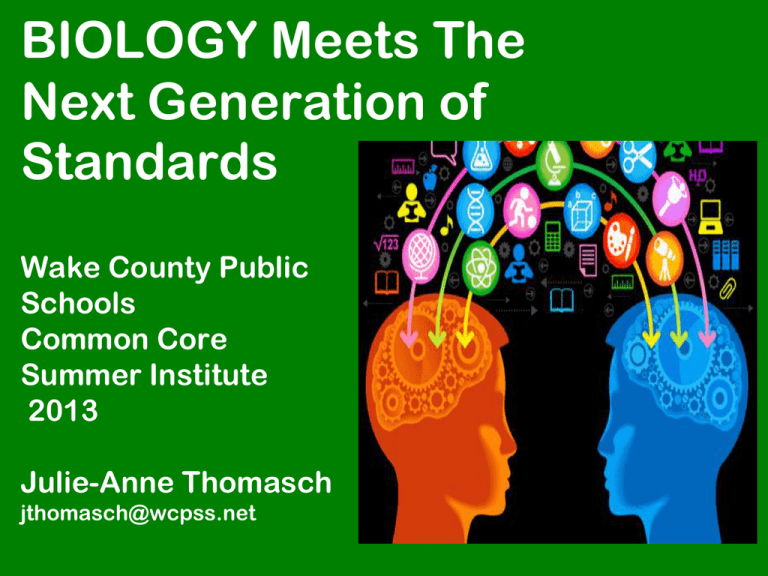
BIOLOGY Meets The Next Generation of Standards Wake County Public Schools Common Core Summer Institute 2013 Julie-Anne Thomasch jthomasch@wcpss.net What are the Next Generation of Standards for Biology ? Life Sciences http://www.nextgenscience.org What does this mean for Wake County/NC Biology teachers ? if -NC helped create the Next Generation Standards - the state does not know when and/or they will be adopted -more focus is being put on literacy and common core practices into science courses -wake co. plans on focusing on training science teachers this school year on the engineering design model NGSS LIFE SCIENCES KEY UNITS / PERFORMANCE EXPECTATIONS 4 Disciplinary Core Ideas: LS1 – From Molecules to Organisms: Structures and Process LS2 – Ecosystems: Interactions, Energy, and Dynamics LS3 – Heredity: Inheritance and Variation of Traits LS4 – Biological Evolution: Unity and Diversity (Story Line/Summary) Detailed Standards with Performance Expectations also include: - Science and Engineering Practices - Disciplinary Core Ideas - Crosscutting Concepts - Common Core State Connections (ELA/Literacy and Mathematics) Current NC Biology Essential Standards VS Next Generation Life Science Standards Example: NC Bio Standard Bio.4 – Molecular Biology Key Topics: Matter, Mass, and Atoms, Water, pH, Organic Compounds Objectives: Bio.4.1.1 - Compare the structures and functions of the major biological molecules (carbohydrates, proteins, lipids, and nucleic acids) as related to the survival of living organisms Bio.4.1.2 - Summarize the relationship among DNA, proteins and amino acids in carrying out the work of cells and how this is similar in all organisms. Bio 4.2.2 - Explain ways that organisms use released energy for maintaining homeostasis (active transport) Connections to Performance Assessments (Next Generation Standards): HS-LS1-1: Construct an explanation based on evidence for how the structure of DNA determines the structure of proteins which carry out the essential functions of life through systems of specialized cells. HS-LS1-3: Plan and conduct an investigation to provide evidence that feedback mechanisms maintain homeostasis. HS-LS1-6: Construct and revise an explanation based on evidence for how carbon, hydrogen, and oxygen from sugar molecules may combine with other elements to form amino acids and/or other large carbon-based molecules. HS-LS2-6: Evaluate the claims, evidence, and reasoning that the complex interactions in ecosystems maintain relatively consistent numbers and types of organisms in stable conditions, but changing conditions may result in a new ecosystem. Examples of Constructed Responses with Connections to Common Core Literacy 1)Compare and contrast the structures and functions of the four key organic compounds: carbohydrates, proteins, lipids, and nucleic acids. 2) Predict what might happen if a cell does not have enough carbohydrates. 3) Assess why polarity is an essential property for water molecules. 4) Critique the potential impact of changing pH for living systems. 5) Recommend changes to your current diet which would make it more nutritious NOTE: More details, examples and connections can be found on Cmapp for all current standards So how do we move forward? Strategies: -Varied questioning and checking for understanding/mastery of material using Bloom’s Taxonomy(Verbal, labs, activities, benchmarks, midterm, tests and quizzes, EOC, etc…) -Inquiry Based labs and hand’s on types of activities -Project Based Learning -Differentiation (varied instruction methods, resources, grouping of students, assessments, etc… ) -literacy based activities Ex: Attend Chad’s presentation -incorporate more reading, writing, and math (Common Core) -Include Engineering design model/practices Examples of Activities, labs, web quests, etc to model current Biology, Common Core, and Next Gen. Standards LS1 – From Molecules to Organisms: Structures and Process HS-LS1-5: Use a model to illustrate how photosynthesis transforms light energy into stored chemical energy. Examples: Lab-Seed Germination, Modeling Photosynthesis, And Evaluating Photosynthesis and Cellular Respiration Experiments Worksheet LS2 – Ecosystems: Interactions, Energy, and Dynamics HS-LS2-7: Design, evaluate, and refine a solution for reducing the impacts of human activities on the environment and biodiversity. Example: Environmental Concerns Web Quest LS3 – Heredity: Inheritance and Variation of Traits HS-LS3-1: Ask questions to clarify relationships about the role of DNA and chromosomes in coding the instructions for characteristic traits passed from parents to offspring. Example: Lab-Protein Synthesis LS4 – Biological Evolution: Unity and Diversity HS-LS4-5: Evaluate the evidence supporting claims that changes in environmental conditions may result in: (1) increases in the number of individuals of some species, (2) the emergence of new species over time, and (3) the extinction of other species Example: can be related back to the environmental concerns web quest and protein synthesis creating a bug
